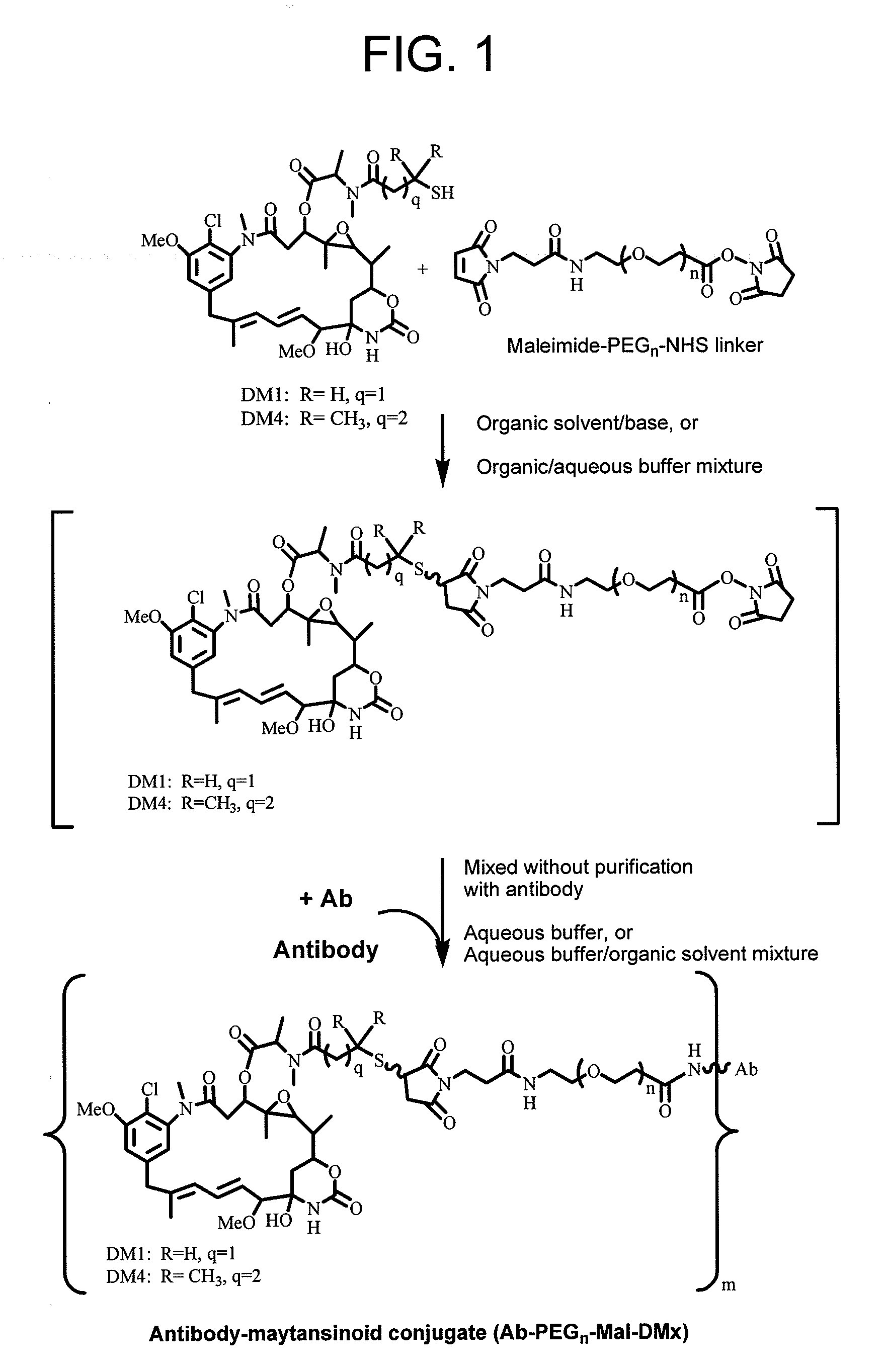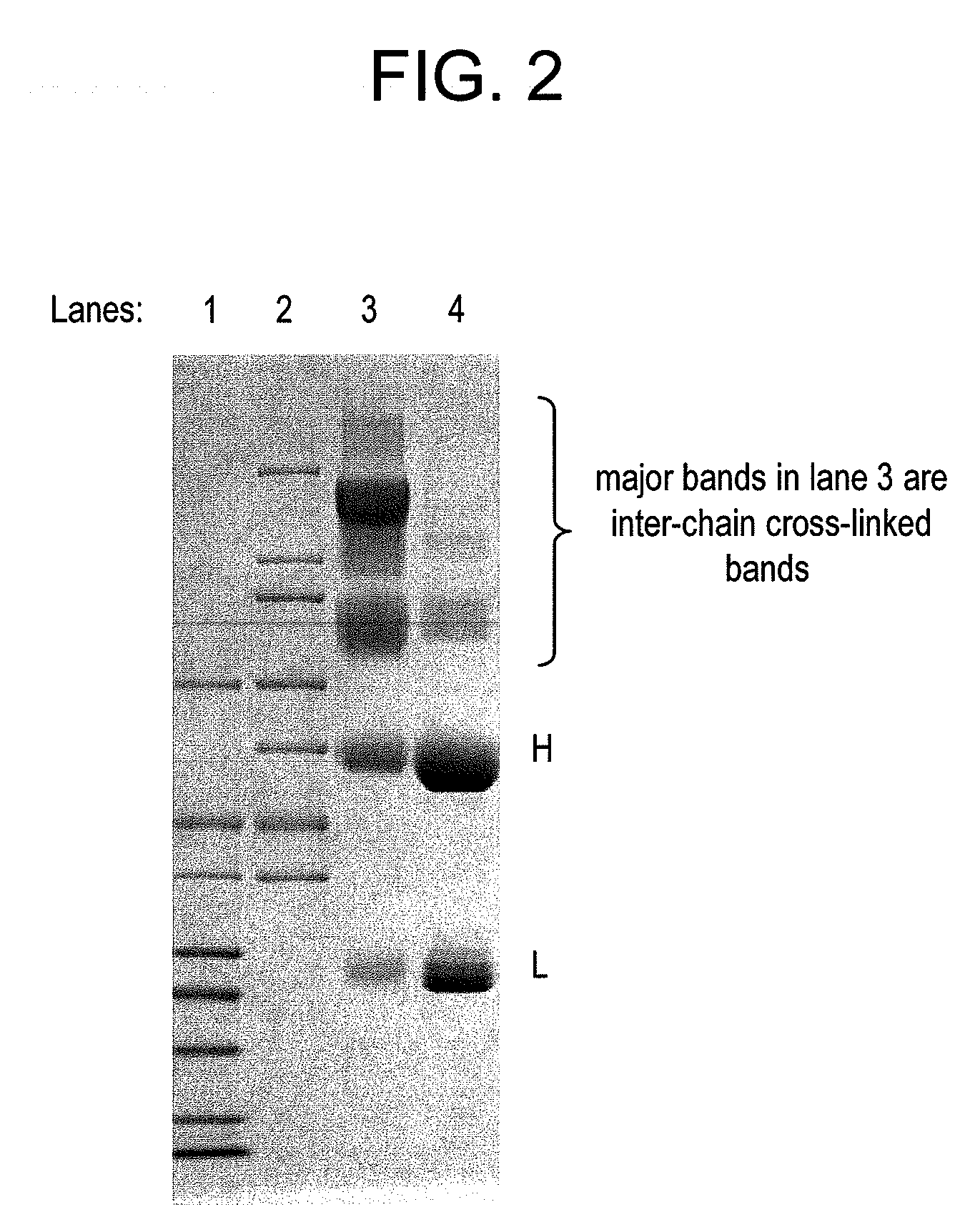Conjugation methods
a technology of conjugation and methods, applied in the field of conjugation methods, can solve the problems of low overall yield, uneconomical scale-up, cumbersome process, etc., and achieve the effect of reducing potential steric hindrances
- Summary
- Abstract
- Description
- Claims
- Application Information
AI Technical Summary
Benefits of technology
Problems solved by technology
Method used
Image
Examples
example 1
Conjugation of Antibody with Cytotoxic Agent DM1 / DM4 Using Heterobifunctional Linker Maleimide-PEGn-NHS by this Method (FIG. 1) Versus Traditional Two-Step Method
[0133]Stock solutions of DM1 [N2′-deacetyl-N2′-(3-mercapto-1-oxopropyl)-maytansine], or DM4 [N2′-deacetyl-N2′-(4-mercapto-4-methyl-1-oxopentyl)maytansine] (DMx) thiol and the Maleimide-PEGn-NHS bifunctional linker were made up in N,N-dimethylacetamide (DMA) at concentrations of 30-60 mM. The linker and DMx thiol were mixed together in DMA containing up to 50% v / v of 200 mM succinate buffer, 2 mM EDTA, pH 5.0 to give a molar ratio of DMx to linker of 1.6:1 and a final concentration of DMx equal to 15 mM. After mixing, the reaction mixture was left for 1-4 h and then an aliquot of the reaction mixture was diluted 10 fold and its absorbance measured at 302-320 nm to determine the presence of any remaining unreacted maleimide using the extinction coefficient (ε) of maleimide at 302 nm=620 M−1 cm−1, and ε320 nm˜450 M−1 cm−1. (Ad...
example 2
Conjugation of Antibody with DM1 / DM4 Using Maleimide-Sulfo-NHS Linker by this Method (FIG. 7) Versus Traditional Sequential Two-Step Method
[0143]Stock solutions of DMx thiol and the maleimide-Sulfo-NHS heterobifunctional linker were made up in N,N-dimethylacetamide (DMA) at concentrations of 30-60 mM. The linker and DMx thiol were mixed together in DMA containing up to 40% v / v of 200 mM succinate buffer, 2 mM EDTA, pH 5.0 to give a ratio of DMx to linker of 1.6 and a final concentration of DMx equal to 15 mM. After mixing, the reaction was left for 1-4 h and then an aliquot of the reaction mixture was diluted 10 fold to measure the absorbance at 302-320 nm for assessing the completion of reaction and the absence of maleimide. (Additional reverse phase HPLC analysis of a frozen aliquot of the reaction mixture was carried out later with absorbance monitoring at 302 nm and 252 nm to verify complete disappearance of linker maleimide and formation of the desired linker-DMx reagent at the...
example 3
Conjugation of Antibody with Maytansinoid (DM1 / DM4) Using Sulfo-NHS-SMCC Linker (FIG. 13)
[0150]Stock solutions of DM1 or DM4 thiol (DMx) and the sulfo-SMCC heterobifunctional linker with sulfo-NHS group (purchased from Pierce Endogen; FIG. 13) were prepared in DMA at concentrations of 30-60 mM. Linker and DM1 or DM4 thiol were mixed together in DMA containing up to 40% v / v of aqueous 200 mM succinate buffer, 2 mM EDTA, pH 5.0 to give a ratio of DM1 or DM4 (DMx) to linker of 1.6:1 and a final concentration of DMx of 6 mM. After mixing, the reaction was left for 1-4 h at ambient temperature and then an aliquot of the reaction mixture was diluted 10-fold to measure absorbance at 302-320 nm to assess whether all of the maleimide had reacted. (Additional reverse phase HPLC analysis of a frozen aliquot of the reaction mixture was carried out later with monitoring at 302 nm and 252 nm to verify complete disappearance of linker maleimide and formation of the desired sulfo-NHS-linker-Mal-DMx...
PUM
| Property | Measurement | Unit |
|---|---|---|
| Fraction | aaaaa | aaaaa |
| Fraction | aaaaa | aaaaa |
| Fraction | aaaaa | aaaaa |
Abstract
Description
Claims
Application Information
 Login to View More
Login to View More - R&D
- Intellectual Property
- Life Sciences
- Materials
- Tech Scout
- Unparalleled Data Quality
- Higher Quality Content
- 60% Fewer Hallucinations
Browse by: Latest US Patents, China's latest patents, Technical Efficacy Thesaurus, Application Domain, Technology Topic, Popular Technical Reports.
© 2025 PatSnap. All rights reserved.Legal|Privacy policy|Modern Slavery Act Transparency Statement|Sitemap|About US| Contact US: help@patsnap.com



